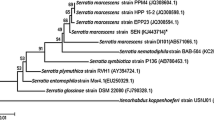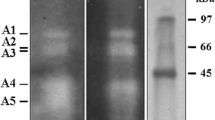Abstract
An endophytic Serratia marcescens strain SRM (MTCC 8708) isolated from the flowers of summer squash was found to be entomopathogenic against the larvae of Helicoverpa armigera. Natural epizootic of this bacterial strain on the larvae collected from summer squash flowers ranged from 19.9 to 72.3%. Under laboratory conditions, a dose of 6 × 1010 c.f.u./ml diet induced 66.3% mortality of first instar H. armigera larvae. Similarly all other growth and development parameters of the insect were severely retarded in a dose-dependent manner. The bacterium invaded the entire alimentary canal and haemolymph with successful replacement of all other gut-associated microflora. There was a great reduction in midgut proteinase activity due to inhibition of five major proteinase isozymes by S. marcescens infection. Further, a synergistic interaction between chitinases isolated from this strain and Bacillus thuringiensis Cry1Ac toxin was observed. The present findings suggest that this plant-associated S. marcescens strain SRM could be suitably exploited for the management of H. armigera.



Similar content being viewed by others
References
Asano S, Suzuki K, Hori H, Watanabe T (1999) Synergistic effects of supernatants from Serratia marcescens culture on larvicidal activity of Bacillus thuringiensis Cry1Ac toxin against common cutworm, Spodoptera litura. J Pestic Sci 24:44–48
Ashelford KE, Fry JC, Bailey MJ, Day MJ (2002) Characterization of Serratia isolates from soil, ecological implications and transfer of Serratia proteamaculans subsp. quinovora Grimont et al. 1983 to Serratia quinivorans corrig., sp. nov. Int J Syst Evol Microbiol 52:2281–2289
Azevedo JL, Maccheroni W Jr, Pereira JO, Araújo WL (2000) Endophytic microorganisms: a review on insect control and recent advances on tropical plants. Elect J Biotechnol 20:40–65
Bosa O, Felipe C, Cotes AM (2004) Effect of culture conditions on the entomopathogenic activity of Serratia marcescens against Tecla Solanivora (Lepidoptera: Gelechiidae). Rev Colomb Entomol 30:87–92
Brurberg MB, Nes IF, Eijsink VG (1996) Comparative studies of chitinases A and B from Serratia marcescens. Microbiol 142:1581–1589
Bruton BD, Mitchell F, Fletcher J, Pair SD, Wayadande A, Melcher U, Brady J, Bextine B, Popham TW (2003) Serratia marcescens, a phloem-colonizing, squash bug-transmitted bacterium: causal agent of cucurbit yellow vine disease. Plant Dis 87:937–944
Dillon RJ, Vennard CT, Buckling A, Charnley AK (2005) Diversity of locust gut bacteria protects against pathogen invasion. Ecol Lett 8:1291–1298
Dodd SJ, Hurst MRH, Glare TR, O’Callaghan M, Ronson CW (2006) Occurrence of sep insecticidal toxin complex genes in Serratia spp. and Yersinia frederiksenii. Appl Environ Microbiol 72:6584–6592
Downing KJ, Leslie G, Thomson JA (2000) Biocontrol of the sugarcane borer Eldana saccharina by expression of the Bacillus thuringiensis cry1Ac7 and Serratia marcescens chiA genes in sugarcane-associated bacteria. Appl Environ Microbiol 66:2804–2810
Escobar MM, Carbonell GV, Beriam LOS, Siqueira WJ, Yano T (2001) Cytotoxin production in phytopathogenic and entomopathogenic Serratia marcescens. Rev Latinoam Microbiol 43:165–170
Garcia-Carreno F, Dimes L, Haard N (1993) Substrate gel electrophoresis for composition and molecular weight of proteases or protease inhibitors. Anal Biochem 14:65–69
Gomez KA, Gomez AA (1984) Statistical procedures for agricultural research. John Wiley & Sons, Singapore
Grimont PAD, Grimont F (1978) The genus Serratia. Annu Rev Microbiol 32:221–248
Grimont F, Grimont PAD (1992) The genus Serratia. In: Balows A, Truper HG, Dworkin M, Harder W, Schleifer KH (eds) The prokaryotes. Springer, New York, pp 2822–2848
Gyaneshwar P, James EK, Mathan N, Reddy PM, Reinhold-Hurek B, Ladha JK (2001) Endophytic colonization of rice by a diazotrophic strain of Serratia marcescens. J Bacteriol 183:2634–2645
Jackson TA, Boucias DG, Thaler JO (2001) Pathobiology of amber disease, caused by Serratia spp., in the New Zealand grass grub, Costelytra zealandica. J Invertebr Pathol 4:232–243
Jackson TA, Christeller JT, McHenry JZ, Laing WA (2004) Quantification and kinetics of the decline in grass grub endopeptidase activity during initiation of amber disease. J Invertebr Pathol 86:72–76
Jeong HU, Mun HY, Oh HK, Kim SB, Yang KY, Kim I, Lee HB (2010) Evaluation of insecticidal activity of a bacterial strain, Serratia sp. EML-SE1 against diamondback moth. J Microbiol 48:541–545
Kunitz M (1947) Crystalline soybean trypsin inhibitor II. General properties. J Gen Physiol 30:291–310
Lee MK, Milne A, Ge, Dean DH (1992) Location of Bombyx mori receptor binding region of a Bacillus thuringiensis δ-endotoxin. J Biol Chem 267:3115–3121
Marchetti S, Chiaba C, Chiesa F, Bandiera A, Pitotti A (1998) Isolation and partial characterization of two trypsins from the larval midgut of Spodoptera littoralis (Boisduval). Insect Biochem Molec Biol 28:449–458
Navon A (2000) Bioassays of Bacillus thuringiensis products used against agricultural pests. In: Navon A, Ascher KRS (eds) Bioassays of entomopathogenic microbes and nematodes. CABI Publishing, CAB International, UK, pp 1–72
Nian-Long Y, Sin-Xin Q, Hong H, Xiong G, Fang-Pong H (2005) Construction of antagonistic, insecticidal, and endophytic strains of Bacillus spp. by protoplast fusion. Chinese J Agrl Biotechnol 2:131–135
Nuñez-Valdez ME, Calderón MA, Aranda E et al (2008) Identification of a putative Mexican strain of Serratia entomophila pathogenic against root-damaging larvae of Scarabaeidae (Coleoptera). Appl Environ Microbiol 74:802–810
Queiroz BPV, Melo IS (2006) Antagonism of Serratia marcescens towards Phytophthora parasitica and its effects in promoting the growth of citrus. Brazilian J Microbiol 37:448–450
Rascoe J, Berg M, Melcher U, Mitchell FL, Bruton BD, Pair SD, Fletcher J (2003) Identification, phylogenetic analysis, and biological characterization of Serratia marcescens strains causing cucurbit yellow vine disease. Phytopathol 93:1233–1239
Sampson MN, Gooday GW (1998) Involvement of chitinases of Bacillus thuringiensis during pathogenesis in insects. Microbiol 144:2189–2194
Sanchez AR, Camarillo RC, Hernández RS, Corona JEB (2005) Chitinases from Serratia marcescens Nima. Biotechnol Lett 27:649–653
Selvakumar G, Mohan M, Kundu S, Gupta AD, Joshi P, Nazim S, Gupta HS (2008) Cold tolerance and plant growth promotion potential of Serratia marcescens strain SRM (MTCC 8708) isolated from flowers of summer squash (Cucurbita pepo). Lett Appl Microbiol 46:171–175
Sikorowski PP, Lawrence AM (1998) Transmission of Serratia marcescens (Enterobacteriaceae) in adult Heliothis virescens (Lepidoptera: Noctuidae). laboratory colonies. Biol Cont 12:50–55
Zhang CX, Yang SY, Xu MX, Sun J, Liu H, Liu JR, Liu H, Kan F, Sun J, Lai R, Zhang KY (2009) Serratia nematodiphila sp. nov., associated symbiotically with the entomopathogenic nematode Heterorhabditidoides chongmingensis (Rhabditida: Rhabditidae). Int J Syst Evol Microbiol 59:1603–1608
Acknowledgments
The authors are grateful to Indian Council of Agricultural Research (ICAR) for funding the study.
Author information
Authors and Affiliations
Corresponding author
Rights and permissions
About this article
Cite this article
Mohan, M., Selvakumar, G., Sushil, S.N. et al. Entomopathogenicity of endophytic Serratia marcescens strain SRM against larvae of Helicoverpa armigera (Noctuidae: Lepidoptera). World J Microbiol Biotechnol 27, 2545–2551 (2011). https://doi.org/10.1007/s11274-011-0724-4
Received:
Accepted:
Published:
Issue Date:
DOI: https://doi.org/10.1007/s11274-011-0724-4




